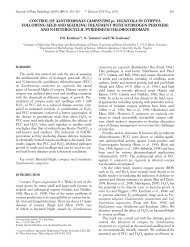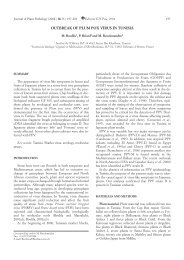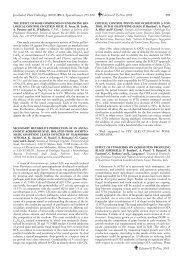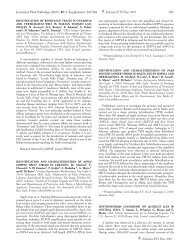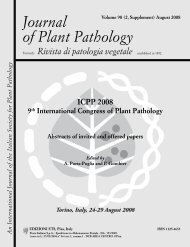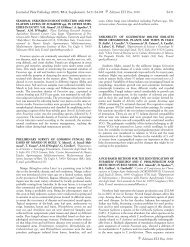Journal of Plant Pathology - Sipav.org
Journal of Plant Pathology - Sipav.org
Journal of Plant Pathology - Sipav.org
Create successful ePaper yourself
Turn your PDF publications into a flip-book with our unique Google optimized e-Paper software.
<strong>Journal</strong> <strong>of</strong> <strong>Plant</strong> <strong>Pathology</strong> (2011), 93 (1, Supplement), S1.43-S1.51 S1.47<br />
<strong>of</strong> the bacterial isolates from 53 red and white wine samples were<br />
able to produce biogenic amines. Tyramine, histamine and ethylamine<br />
were the major biogenic amines detected. Bacterial strains<br />
were identified by specifically amplified polymorphic DNA–polymerase<br />
chain reaction (SAPD-PCR), a molecular fingerprinting<br />
method based on the amplification <strong>of</strong> species-specific gene sequences.<br />
Kaschak E., Göhring N., König H., Pfeiffer P., 2009. Biogene Amine<br />
in deutschen Weinen: Analyse und Bewertung nach Anwendung<br />
verschiedener HPLC-Verfahren. Deutsche Lebensmittel-Rundschau<br />
105: 375-384.<br />
ESTIMATION AND QUANTIFICATION OF COPPER<br />
AND TEMPERATURE EFFECTS ON GROWTH OF VINE<br />
SPOILAGE FUNGI AND GEOSMIN PRODUCTION BY<br />
PENICILLIUM EXPANSUM. C. Charpentier 3 , D. Correia 1 , P.<br />
Dantigny 2 and M. Bensoussan 1 . 1 AgroSup Dijon - Bâtiment<br />
Erasme, GTR Myco SMAE – Microbiologie, 1 Esplanade Erasme,<br />
21000 Dijon, France. 2 AgroSup Dijon - Bâtiment Erasme Laboratoire<br />
GPMA 1 Esplanade Erasme, 21000 Dijon, France. 3 UMR<br />
INRA 1131, IUVV, Université de Bourgogne, 1 Rue Claude<br />
Ladrey, 21000 Dijon, France. E-mail: Claudine.Charpentier@<br />
u-bourgogne.fr<br />
Copper is an active component <strong>of</strong> many fungicides used in<br />
agriculture and especially in vineyard treatments. The effect <strong>of</strong><br />
copper (II) ions on the growth <strong>of</strong> two grape rot fungi, Botrytis<br />
cinerea and Penicillium expansum was evaluated. Both fungi were<br />
grown on Czapek agar medium, at 15, 20 and 25°C, with different<br />
concentrations <strong>of</strong> copper added, and the radial growth rate<br />
was determined. The combined effects <strong>of</strong> copper, temperature<br />
and carbon dioxide, on geosmin production by P. expansum were<br />
also studied. An experimental device hermetically closed was developed<br />
for easy monitoring <strong>of</strong> fungal growth. Experiments were<br />
carried out according to a Doehlert matrix. Depending on the<br />
temperature, these fungi grew up to 10 mM copper. B. cinerea, a<br />
fast grower, had higher growth rates than P. expansum, i.e.: 1.50<br />
mm×day -1 and 0.20 mm×day -1 respectively, in the presence <strong>of</strong><br />
copper 4 mM. At the Geosmin production by P. expansum depended<br />
on copper level. In particular, there was an increased<br />
production up to a rate between 1 and 1.2 mM (63.75 and 76.50<br />
mg l -1 ), a decrease at higher concentrations and total inhibition <strong>of</strong><br />
production beyond 5.2 mM (331.50 mg l -1 ). Under experimental<br />
conditions <strong>of</strong> Doelhert matrix, effects were established <strong>of</strong> interactions<br />
between factors. Contrary to copper, temperature and CO 2<br />
had negative effects on geosmin production. Measurement <strong>of</strong> individual<br />
and interaction effects <strong>of</strong> these factors on B. cinerea and<br />
P. expansum development will contribute to a more appropriate<br />
use <strong>of</strong> pesticides to prevent <strong>org</strong>anoleptic defects <strong>of</strong> biological origin.<br />
Depending on the temperature, the Bordeaux mixture (0.16<br />
to 0.32 mM copper) used in vineyards may have a positive effect<br />
on the growth <strong>of</strong> these fungi and even a positive effect on<br />
geosmin production by P. expansum.<br />
IMPACT OF GRAPE VARIETY AND WINE TYPE ON<br />
THE PERCEPTION THRESHOLDS OF ROT-RELATED<br />
MUSTY AND MOULDY OFF-FLAVOUR COMPOUNDS IN<br />
WINE. A. Fuhrmann, V. Schaefer and R. Jung. Forschungsanstalt<br />
Geisenheim, Fachgebiet Kellerwirtschaft, Blaubachstrasse 19,<br />
65366 Geisenheim, Germany. E-mail: v.schaefer@fa-gm.de<br />
In the last years, an increasing amount <strong>of</strong> wines suffering from<br />
musty and mouldy <strong>of</strong>f-flavours caused by rot on grapes was reported<br />
by different authors (Darriet et al., 2000, La Guerche et<br />
al., 2006; Eder et al., 2008). Among others, the compounds<br />
geosmin, 2-methylisoborneol (MIB) and 1-octen-3-ol were identified<br />
as the cause <strong>of</strong> an earthy, mouldy or mushroom like <strong>of</strong>fflavour<br />
in wine. Geosmin (trans-1,10,dimethyl-trans-9-decalol), is<br />
a metabolite <strong>of</strong> various actinomycetes and fungi. In wine, its<br />
source can be linked to the effect <strong>of</strong> rot on grapes, especially secondary<br />
rot inducers like Penicillium spp. can produce high<br />
geosmin amounts in infected grapes. Geosmin is stable during alcoholic<br />
fermentation and is transferred into wine (La Guerche et<br />
al., 2006). Along with geosmin, 2-methylisoborneol, and 1-octen-<br />
3-ol are known as compounds closely linked with the growth <strong>of</strong><br />
moulds (Simpson, 2005). 1-octen-3-ol is a typical mould metabolite<br />
responsible for a typical fungal and mouldy flavour. MIB, a<br />
metabolite <strong>of</strong> B. cinerea, some Penicillium spp. and Streptomyces<br />
spp. has a flavour mainly described as earthy, musty and camphor<br />
(Kugler and Rapp, 1997; Hesford and Schneider, 2002; La<br />
Guerche et al., 2006). During a research project at the Geisenheim<br />
Research Center (Germany), the effect <strong>of</strong> wine style and<br />
grape variety on perception thresholds <strong>of</strong> geosmin, 2-<br />
methylisoborneol, and 1-octen-3-ol was tested in different sensory<br />
trials. Three white wines from Germany [cvs Gewürztraminer<br />
(sweet), Riesling (dry) from Rheingau, and cv. Riesling (dry) from<br />
Mosel] and two red wines, one from Germany [cv. Pinot noir<br />
(dry) from Rheingau] and one from south-east Australia (cv. Merlot,<br />
dry) were spiked with different amounts <strong>of</strong> the above mentioned<br />
compounds and evaluated by a panel consisting <strong>of</strong> 15 experienced<br />
tasters. Perception thresholds for geosmin in the tested<br />
white wines were between 40 and 45 ng/l and up to 180 ng/l in<br />
the red wines. For the 1-octen-3-ol the perception thresholds for<br />
the white and red wines were between 6 and 12.5 µg/l. As to 2-<br />
methylisoborneol, the panellists found perception thresholds between<br />
12.5 and 35 ng/l.<br />
Darriet P., Pons M., Lamy S., Dubourdieu D., 2000. Identification<br />
and Quantification <strong>of</strong> Geosmin, an Earthy Odorant Contaminating<br />
Wines. <strong>Journal</strong> <strong>of</strong> Agriculture and Food Chemistry 48: 4835-<br />
4838.<br />
Eder R., Weingart G., Brandes W., 2008. Occurrence <strong>of</strong> geosmin in<br />
Austrian wines, reduction by means <strong>of</strong> special filter layers and estimation<br />
<strong>of</strong> sensory threshold values. Book <strong>of</strong> Abstracts Grapelux,<br />
Remich 2008: 14.<br />
Hesford F., Schneider K., 2002. Entstehung von Korkton im Wein.<br />
Schweizerische Zeitschrift für Obst- und Weinbau 16: 415-417.<br />
Kugler D., Rapp A., 1997. Bildung und Entwicklung von Inhaltsst<strong>of</strong>fen<br />
in Korkborke während des Herstellungsprozesses von<br />
Flaschenkorken. Deutsche Lebensmittel Rundschau 93: 6.<br />
La Guerche S., Douphin B., Pons M., Blancard D., Darriet P., 2006.<br />
Characterization <strong>of</strong> some mushroom and earthy <strong>of</strong>f-odours microbially<br />
induced by the development <strong>of</strong> rot on grapes. <strong>Journal</strong> <strong>of</strong><br />
Agricultural and Food Chemistry 54: 9193-9200.<br />
CHARACTERIZATION AND REMOVAL OF OFF-<br />
FLAVOURS IN WINES. M. Behr 1 , E. Cocco 1 , C. Guignard 1 , D.<br />
Molitor 1 , A. Mehlen 2 and D. Evers 1 . 1 Centre de Recherche Public-<br />
Gabriel Lippmann, Department Environment and Agro-Biotechnologies,<br />
41 Rue du Brill, 4422 Belvaux, Luxembourg. 2 Institut Viti-Vinicole,<br />
Section Viticulture, B.P. 50, 5501 Remich, Luxembourg.<br />
E-mail: behr@lippmann.lu<br />
Geosmin is an unacceptable molecule because <strong>of</strong> the earthymouldy<br />
taste it gives to wines. Geosmin is produced by some<br />
Penicillium spp. in general and by Penicillium expansum in particular.<br />
Its biosynthesis needs a contamination by Botrytis cinerea<br />
(La Guerche et al., 2005). The production <strong>of</strong> geosmin can occur<br />
with a very small percentage <strong>of</strong> Botrytis contaminated berries.



